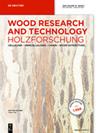Douglas fir bark: composition, extracts utilization and enzymatic treatment for enrichment of bioactive constituents
IF 1.6
3区 农林科学
Q2 FORESTRY
引用次数: 0
Abstract
Bark residues from Douglas fir are an abundant resource that is currently used primarily in low-value energy recovery or is landfilled. Bark extractives are rich in diverse compounds like terpenes, fatty acids, phenols, and sugars with potential uses in a variety of high value applications. The study explores the potential of enzymatic hydrolysis to improve phenolic compounds from Douglas fir bark. It also assesses differences in chemical composition among rhytidome, phloem, and comingled bark fractions from an industrial waste pile. Phloem fractions exhibit higher yields of extractives, rhytidome fractions have elevated lignin levels, while the comingled fraction lies between the two except in ash content which was higher than in the separated fractions. Fungal decay tests with花旗松树皮:成分、提取物利用和酶处理以丰富生物活性成分
花旗松树皮残渣是一种丰富的资源,目前主要用于低价值能源回收或填埋。树皮萃取物富含萜烯、脂肪酸、酚类和糖类等多种化合物,具有多种高价值的潜在用途。本研究探讨了酶水解法改善花旗松树皮中酚类化合物的潜力。研究还评估了来自工业废料堆的流纹体、韧皮部和混合树皮馏分的化学成分差异。韧皮部馏分的萃取物产量较高,流纹部馏分的木质素含量较高,而混合馏分介于两者之间,但灰分含量高于分离馏分。用 Gloeophyllum trabeum 和 Coniophora puteana 对萃取物处理过的木材进行的真菌腐烂测试表明,萃取物具有潜在的生长抑制作用,质量损失(平均)分别约为 58-31% 和 30-7%,但由于低浓度时质量损失较高,因此采用酶改性方法似乎对增强抑制作用至关重要。全细胞发酵法的生长反应因参与发酵的微生物而异。用β-葡萄糖苷酶进行酶水解可提高树皮提取物的抗氧化性,并有望改变化学成分和提高生物活性。
本文章由计算机程序翻译,如有差异,请以英文原文为准。
求助全文
约1分钟内获得全文
求助全文
来源期刊

Holzforschung
工程技术-材料科学:纸与木材
CiteScore
4.60
自引率
4.20%
发文量
83
审稿时长
3.3 months
期刊介绍:
Holzforschung is an international scholarly journal that publishes cutting-edge research on the biology, chemistry, physics and technology of wood and wood components. High quality papers about biotechnology and tree genetics are also welcome. Rated year after year as one of the top scientific journals in the category of Pulp and Paper (ISI Journal Citation Index), Holzforschung represents innovative, high quality basic and applied research. The German title reflects the journal''s origins in a long scientific tradition, but all articles are published in English to stimulate and promote cooperation between experts all over the world. Ahead-of-print publishing ensures fastest possible knowledge transfer.
 求助内容:
求助内容: 应助结果提醒方式:
应助结果提醒方式:


